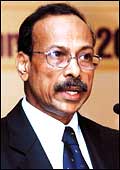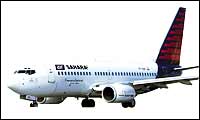|
Even
as airbus industrie created aviation history last fortnight by
successfully putting to air its biggest jumbo aircraft thus far,
the A380-it can seat 555 passengers in a typical three-class configuration-its
losing streak in the aviation market only seemed to get worse.
Its most recent setback, of course, has been in India, where flagship
carrier Air-India (a-i), picked American rival Boeing over Airbus
for a $6.9-billion (Rs 30,360-crore) deal to purchase 50 new aircraft.
Not surprisingly, Airbus is crying foul, saying that bid conditions
were changed at the last minute to favour Boeing, and that its
two latest planes-the A350 and the A380-were not even considered.
The European aircraft maker has even demanded a vigilance enquiry
into the decision.
But could it be that the Boeing
787 Dreamliner is actually a better option for carriers? Going
purely by the Chicago-based manufacturer's recent wins, the answer
seems to be yes. Air Canada recently placed a $15-billion (Rs
66,000-crore) order for 96 Boeing planes, including 14 787s. So
have Japan Airlines (30 787s), Korean Air (14), and six different
Chinese airlines (for 60 787s). Indeed, of the 50 planes (15 are
optional) that A-I plans to buy, 27 are 787s (of the other 23,
15 are 777-300er long-range aircraft and eight 777-200lr ultra
long-haul jetliners). The 787's USP? It is 20 per cent more fuel
efficient compared to the current generation jetliners like the
Airbus A330 and costs one-third less in maintenance, because of
its lightweight composite building materials and improved engines
(besides, it offers wireless on-board systems). But Nigel Harwood,
Airbus' Vice President (Sales), Indian subcontinent and South
Asia, says that the plane most suitable for India is the A380,
"which is 31 per cent more economical than the 787 and will
be available for delivery from 2006 onwards".
There's still a ray of hope for Airbus. The
deal, while cleared by the A-I board, now needs the Government
of India's approval. Let's see if it can come up with any last-minute
surprise manoeuvres.
-Sahad P.V. and Kushan Mitra
LIFT
A-I's Belated Take Off
 |
| A-I CMD V. Thulasidas: Buckle up |
The
last time Air-India (A-I) expanded its fleet was about 15 years
ago. The 38 aircraft in its fleet today have an average age of
13, with only 36 in active service. As a result, despite having
15,500 (fy2004) people on its payroll and rights to fly to over
100 countries around the world, A-I is a white elephant, with
Rs 5,897 crore in revenues and Rs 900 crore in accumulated losses
till last year (it did make Rs 92 crore in net profits, though,
last year). In the recent years, it has lost market share on key
sectors to foreign carriers such as Emirates and Singapore Airlines.
The Boeing order for 50 aircraft, then, is like a lucky wind that
could see the carrier gain market share on the lucrative India-us
and India-Europe routes. The only catch: Deliveries don't start
until 2006 (the 787s come much later in 2008), by when even local
rivals like Jet Airways and Air Sahara, which have been allowed
to fly international destinations, would have muscled their way
onto A-I's turf.
-Kushan Mitra
Q&A
"It Takes Time To Become Global"
After
37 years with the HSBC group,
David Eldon retires in May as the Chairman of the Hongkong
and Shanghai Banking Corporation. An old Asia hand, Eldon spoke
to BT's R. Sridharan on banking
in India and Asia. Excerpts:
India would like Mumbai to be at least
an Asian financial hub. How would you rate its chances?
It's a fairly complex answer. If you want
to be a financial hub, you first have to decide who's your customer
and who's your competition. The latter would be Hong Kong or Japan
or Singapore. The financial hubs of the future would be Shanghai
and Seoul. What do you need to be a financial hub? A legal structure
that's quick and transparent, international expertise and a market-friendly
regulatory structure, which allows banks to come in.
So how would you rate Mumbai on these
parameters?
I would honestly have to put Mumbai closer
to the bottom of the list of existing or upcoming financial hubs.
But I am not saying it can't be done. Only that it needs a lot
of work.
Do you see a global bank coming out of
India in five or 10 years time?
It takes a long time to be a global force.
In fact, there are hardly any global banks... we clearly are one.
Even if you look at some major European banks, they are not global.
They may have offices internationally, but I don't think they
could say that they do business in all of them. If we use that
as a clarification, there's no reason why some of the major Indian
banks cannot become international, without necessarily being global
banks.
Bt Cotton's Ally
Farmers in Andhra rally around the crop.
 |
| Advantage BT cotton: Higher yield,
lower costs |
Ever
since BT cotton seeds were first introduced in India in 1996 and
approved for commercial production in 2002, there have been restless
debates over it. The debates have ranged from the safety of using
biotechnology in agriculture to cotton productivity to MNC domination
of seed supplies. But slowly, the popular opinion seems to be
leaning towards Bt cotton. (It's called Bt because the seed uses
an insect-resistant gene from the bacterium Bacillus thuringiensis.)
The support is coming from a state that has witnessed a large
number of farmer suicides-Andhra Pradesh. "Farmers who have
used Bt cotton are now reporting better yields," says S.
Jaipal Reddy, Chairman (Cotton Commodity), Confederation of Indian
Farmers' Associations.
In Andhra, the total area under cotton crop,
according to Reddy, is between 20 lakh acres and 25 lakh acres.
Of this, 1.90 lakh acres was under Bt cotton in 2004. Compare
this with 2002, when out of 18 to 20 lakh acres under cotton,
only 6,800 acres was planted with Bt cotton. This year, Bt cotton
may be grown in over 10 lakh acres, Reddy reckons. The Bt cotton
advantages: higher yield and lower (pesticide) costs. At between
eight quintals and 12 quintals per acre, Bt cotton, Reddy claims,
yields 20 per cent more. Abuse of the crop could be disastrous
for Indian farmers. Not interspersing Bt cotton crop with non-Bt
cotton crop can lead to a new variety of pests that are resistant
to all pesticides.
-E. Kumar Sharma
The
BT 50 Index
Despite a jittery fortnight, there are signs
of a consolidation.
With
diverse corporate results-some good, others disappointing-pouring
in, the market remained extremly volatile this fortnight as well.
But with the overall results generally on expected lines, the
BT 50 remained flat at 235.87 points. However, the credit policy
(RBI increased the reverse repo rate by 25 basis points) impacted
bank stocks, which fell by 2.78 per cent. Also with OPEC's support,
global oil prices have gone below $50 (Rs 2,200) per barrel. With
no spike expected in the short term, the stock market can breathe
easy.
Our flagship free float methodology-based
index-BT 50-has completed two years now. The free float methodology
has several advantages: first, it considers only the value of
stocks freely available in the market (after excluding the part
held by promoters and other strategic investors) and the weightage
assigned to individual shares is more representative than the
market capitalisation-based methodology; second, it takes care
of the perpetual selection dilemma regarding closely-held companies.
For instance, the inclusion of these companies may distort the
index based on total market capitalisation methodology, but dropping
them altogether may reduce its representative character. The free
float methodology facilitates inclusion of large closely-held
companies but assigns them a lesser weightage. After the success
of our broad market free float index (that the Sensex subsequently
decided to adopt this is testimony to the efficacy of the free
float method), we decided to launch sector indices using the same
method. While the general index captures the overall movements
(covering several sectors), sector indices capture the movements
in individual sectors. All these indices have a common base period
(January 1, 2002). The weightages are reassigned every quarter
after companies declare their ownership details. The base value
of all BT indices is 100.
-Narendra Nathan
|







